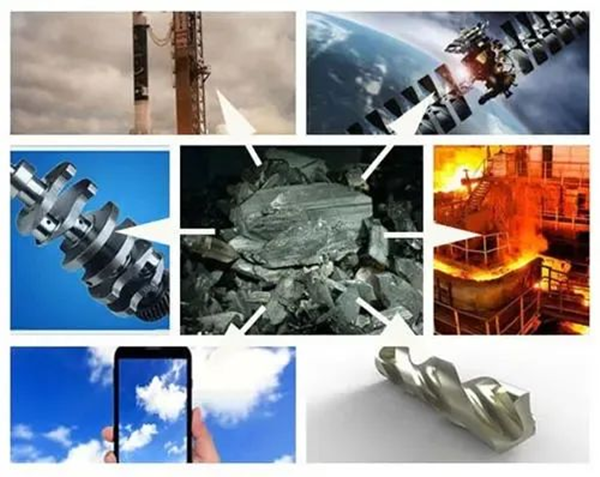Uses and application fields of tungsten
Application of tungsten
The melting point of tungsten is the highest among all metal elements, with a density of 19.3 g/cm ³) It is very high, close to gold, and the hardness of tungsten is also very high. For example, the hardness of tungsten carbide is close to diamond. In addition, tungsten also has good conductivity and thermal conductivity, small expansion coefficient and other characteristics, so it is widely used in alloy, electronics, chemical industry and other fields, among which cemented carbide is the largest consumption field of tungsten.

steel
The hardness of tungsten is very high, and the density of tungsten is close to gold, so it can improve the strength, hardness and wear resistance of steel. As an important alloy element, tungsten is widely used in the production of various steels. Common tungsten containing steels include high-speed steel, tungsten steel and tungsten cobalt magnetic steel with high magnetization and coercive force. These steels are mainly used to manufacture various tools, such as drill bits, milling cutters, wire drawing dies, female dies and male dies.
Tungsten carbide based cemented carbide
Tungsten carbide has high wear resistance and refractory, and its hardness is close to diamond, so it is often used in some cemented carbides. At present, tungsten carbide based cemented carbide is the largest consumption field of tungsten. This cemented carbide is a powder metallurgy product made by sintering tungsten carbide micron powder and metal binder (such as cobalt, nickel, molybdenum) in vacuum furnace or hydrogen reduction furnace. Tungsten carbide based cemented carbides can generally be divided into four categories: tungsten carbide cobalt, tungsten carbide titanium carbide cobalt, tungsten carbide titanium carbide tantalum carbide (niobium) cobalt and steel bonded cemented carbides. These tungsten carbide based cemented carbides are mainly used to manufacture cutting tools, mining tools and wire drawing dies.
Heat strength and wear-resistant alloy
Tungsten has the highest melting point and high hardness among all metals, so it is often used to produce heat strength and wear-resistant alloys. For example, tungsten and chromium, cobalt and carbon alloys are often used to produce high-strength and wear-resistant parts such as valves of aeroengines and turbine impellers, while tungsten and alloys of other refractory metals (such as tantalum, niobium, molybdenum and rhenium) are often used to produce high heat strength parts such as nozzles and engines of aerorockets.
High specific gravity alloy
Because of its high density and hardness, tungsten has become an ideal material for making heavy alloys. These heavy alloys can be divided into W-Ni Fe, W-Ni Cu, W-Co, W-WC Cu, W-Ag and other major series according to their composition, properties and applications. These alloys are widely used in aerospace, aviation Military, oil drilling, electrical instrument, medicine and other industries, such as manufacturing armor, radiator, counterweight of control rudder and contact materials such as knife switch, circuit breaker, spot welding electrode, etc.
Electronics
Tungsten and its alloys are widely used in electronic and power supply industries due to its high plasticity, low evaporation rate, high melting point and strong electron emission ability. For example, tungsten wire has high luminous rate and long service life, so it is widely used in the manufacture of various bulb filaments, such as incandescent lamps, iodine tungsten lamps, etc. Tungsten wire can also be used in the manufacture of the direct hot cathode and grid of electronic oscillator tubes, as well as the side hot cathode heaters in various electronic instruments. The characteristics of tungsten make it suitable for TIG welding and other electrode materials similar to this kind of work.
Chemical industry
Tungsten compounds are often used as catalysts and inorganic colors. For example, tungsten disulfide is used as a lubricant and catalyst in the preparation of synthetic gasoline, bronze colored tungsten oxide is used in painting, and calcium or magnesium tungsten is commonly used in fluorescent powder.
Other areas
As the thermal expansion of tungsten is similar to that of borosilicate glass, it is used for glass or metal sealing. The sensitivity of tungsten is low, so it is used to make high-purity tungsten gold jewelry. In addition, tungsten is also used in radiation medicine, and tungsten wire is also used in some musical instruments.

